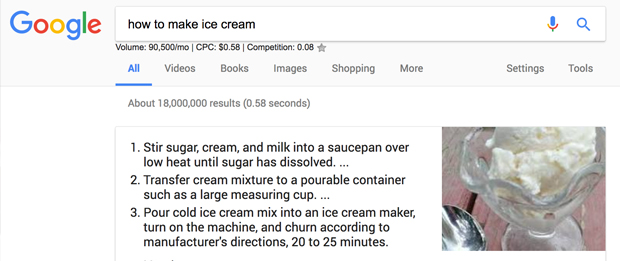How To Rank in Google’s Featured Snippet Box

You may have noticed that Google has made some changes in how they display some search engine query results. Most notable is the increase in the number of Featured Snippets it displays on the top of the search engine results page (SERP). A Featured Snippet (also known as a “rich snippet” and a “rich answer”, among other things) generates a lot of traffic from organic search.
What Exactly Is a Featured Snippet?
If you entered a Google search query for, say, “how do I change my oil and filter”, you’d see a slightly different search result than you might be used to. What appears at the very top of the SERP is a box containing a list of steps to changing the oil and filter on a vehicle, followed by a link to the site where the information was taken from. How great would it be to show up at the very top of the SERP without it costing you a cent?
Rebutting the Detractors
Some detractors of Featured Snippets would have us believe that displaying the answer to a search query right there in the search results will lower traffic to the corresponding site. But, as demonstrated by two case studies published by Search Engine Land, that is not necessarily the case. And, if the list of steps in your Snippet is long enough, searchers will be “forced” to click-through to your website because not all the steps will be listed in the Featured Snippet box.
Getting Ranked in the Featured Snippet
After a fairly exhaustive study of Featured Snippets conducted by Matthew Barby at HubSpot, he identified 7 keys to optimizing web pages for the Featured Snippet position in Google:
- Backlinks don’t matter as much for ranking in the Featured Snippet when your page already ranks on page one. Of course, if your page isn’t already ranking high in the search results, you should make that your first priority. While neither Barby or any other expert who has written about Featured Snippets have said you must rank high in the search engine results, it’s reasonable to assume that’s an important criterion. Not only that, it’s just sound SEO practice to optimize for a page one ranking, regardless of your Featured Snippet ranking. To back that assertion up, I would just say that every page I’ve seen in the Featured Snippet box is also shown at or near the top of page one of the SERP.
- There should be an area on the web page where the search query appears in a header (h2, h3, h4, etc.). Incorporating keywords in page headlines and paragraph titles has always been integral to good SEO. Now it becomes even more important, if you wish to rank for the Featured Snippet box. But it’s important to recognize that, apparently, the exact wording of the search query must appear in one of the headers on the page. Again, no one comes right out and says that, but it’s logical to assume that a header that matches the query exactly will do better in Featured Snippet ranking than one that’s only a partial match.
- The content you wish to have shown in the Featured Snippet (the answer to the query) should be placed inside a <p> tag directly below the header mentioned in number 2 (above). This answer should be between 54–58 words long. This seems to be the ideal, not a hard and fast rule. You can find numerous examples of Featured Snippets (both step-by-step instructions on how to do something, and paragraphs of text) that have far fewer than 54 words. We suggest shooting for the 54-58 word window, but don’t be too concerned if you miss that mark.
- Google doesn’t always just pull an entire paragraph of text into the Featured Snippet. If you put your content in a step-by-step format (“Step 1”, “Step 2”, “Step 3”, etc. as h2 subheadings), Google will sometimes just pull the subheadings and list them chronologically with an ellipsis following each step. This indicates that there’s more information on each step on the webpage itself. This is another way of “forcing” readers to click-through to your website.
- For shorter keywords that are less question-orientated (e.g. “Inbound Marketing”), a Featured Snippet will likely be in the form of a paragraph of text rather than a step-by-step list. Page structure is important here. In this case, you should apply the rule in number 3 (above) that the content you wish to have shown in the Featured Snippet should be placed inside a <p> tag directly below a header (h2, h3, h4, etc.).
- Google tends to prefer ‘answers’ to queries that begin logically, as an answer to a question would. For example, if the query is “how do I bake bread”, the answer for step-by-step instructions might begin with the word “Directions”. If the query is “
- Featured Snippets for the same query often have different content, depending on which geographic version of Google the searcher is using (Google.com, Google.co.uk, Google.com.au, and Google.ie). Since Google.com is designed to serve the world in general, plus the United States, this is probably the one you should be optimizing for.
If you’re looking to increase your site’s visibility by getting featured in the snippet box for the queries you rank well for, run a quick audit of those keywords. Determine which of them are question-based keywords. Then drill down into where you currently rank for those keyword and how well your current content is structured in light of the keys we’ve shared above. Finally, develop a plan to adjust your content based on this information.
Contact us to learn more about the Featured Snippet box and how it can improve your website’s performance. We also invite you to check out the additional resources below for more information and insight on this topic.
Additional Resources:
How to Rank in Google’s Featured Snippets (aka Position 0 on Google)
How to Optimize Your Content for Google’s Featured Snippet Box




